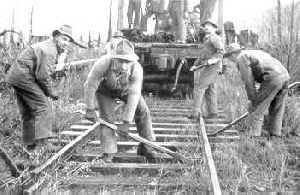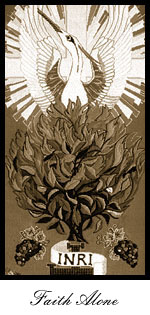
The Mennonite church is considered a historic "peace church." From early on there has been an ongoing emphasis on following the example of Jesus, and therefore not participating in war. Although this emphasis on obedience and discipleship remains strong, church perspectives on peace have changed somewhat.
Initial Persecution 
The Martyrdom of Levina Ghyselins and David van der Leyen Initial Persecution. During the period of persecution in the 1500 and 1600's, Mennonites stressed peace as an alternative to what they saw around them. Wars based on religion pitted "Protestant" and "Catholic" rulers against each other, while both sides persecuted members of other groups in their own territories.
Many Mennonite groups saw this violence as a role of government. As a result, Mennonites often did not allow their members to take part in the government, or other "civil" offices. In the Schleitheim Confession, for example, believers are forbidden to become judges, since Christ taught to "judge not." They reasoned that such positions might be necessary, but it was not the role of a Christian to fill them. "Quiet in the Land" 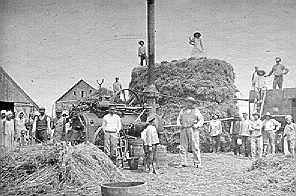
Russian Threshing Scene (1918) After this period of persecution, Mennonites kept to themselves and sought to be the "quiet in the land." They wanted to practice their religious beliefs and social customs with as little interference as possible, but were not very active in the communities around them. Perceived threats to their language,culture, and/or religious beliefs prompted these groups to move regularly.A major condition for them to stay was that they would not have to serve in the military, consistent with their commitment to non-resistance.
Many churches and individuals continue to see the role of the church in Canada as being "the quiet in the land." This idea and the emphasis on non-conformity are two pillars of the Old Order Amish and Old Order Mennonite way of life.
20th Century The 20th Century has proven to be quite a challenge for the Mennonite church in Canada. In a period of world history when there has been bloodshed like never before, this "historic peace church" has attempted to keep the most important aspects of its tradition while dealing with difficult issues.
Although Mennonites have dealt with "Peace issues" during times when our country was not involved in open armed conflict, the war periods provide historical snapshots of how Canadian Mennonite culture and faith reacted to and incorporated the realities around them. World War I 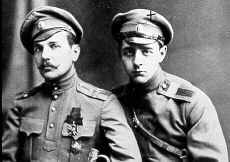
Mennonite soldiers in the Russian Army during World War I. Before the war, Mennonite groups became aware of increasing patriotic fervor in Canada. Nonetheless, the churches continued to teach non-resistance and braced for the coming of hostilities.
At the outbreak of war in Europe the Canadian government moved to support Great Britain and its allies against the German threat. Although Mennonites seemed to be exempt from military service due to agreements made upon their immigration to
Canada, they still had two strikes against them:
1.Most Mennonites spoke German dialects. The country was at war with "the Germans" in Europe - but Mennonites "at home" (in Canada) used this language in their businesses, homes, schools, and churches.
2.The Mennonite community did not wish to join the war effort. For the most part they refused to enter the military,and church members were discouraged from being involved in making weaponry. The great majority of Mennonites in Canada did not enter the war. They were granted exceptions because of their individual and communal religious beliefs. Some were also exempted by working on farms and other areas of food production.
These factors combined to cause Mennonites to be seen with suspicion. As the war dragged on, public opinion became increasingly harsh. Some German-language newspapers and magazines were forbidden to publish, while travelling between the US and Canada became more difficult for German-speaking citizens. When the US entered the conflict late in the War, Mennonite and Hutterite "Conscientious Objectors" began to migrate to Canada. This movement aggravated an already tense situation.
Although most Mennonite individuals and churches stood against the war, some Mennonite youth did enter the armed forces. Some entered in supporting roles such as the medical corps or food service, while others were directly involved in combat.
Mennonites elsewhere were having similar struggles during the war. As if the conflict with Germany were not enough, the Mennonite colonies in Russia were also trapped in their country's civil war. Abused, persecuted, and taken advantage of by rival armies as well as by roaming bandits, some decided that violence was necessary to defend themselves. A minority of Mennonites formed armed "self-defense" movements to protect their villages. The tense situation prompted Mennonites in Russia to look for possibilities for large-scale immigration.
However, the Canadian government halted all Mennonite immigration after World War I, partially as a result of the majority of Mennonite's refusal to participate in the War effort. It was only after several years of negotiations and lobbying that Mennonites were again allowed to enter the country in 1922. From this point until 1930 approximately 21,000 Mennonites migrated from Russia to Canada. |  |
 |  |  |
 | World War II Conscientious Objectors Doing Alernative Service during World War II. 
Alternative Service Work Camp World War II forced the issue of "peace" once again. The Mennonites contended that they could not participate in war because it violated their personal conscience and community religious views. Although some Mennonites were still exempt from military service due to agreements made in the 1870s, those who had immigrated after World War I were not.
Many of those who did not qualify for exemption sought to be recognized as "Conscientious Objectors," and not incorporated into the military. Several delegations of Mennonite leaders went to Ottawa to clarify their position and petition government officials. Since there was no central organization, however, different Mennonite groups were often unaware of the actions and agreements of their counterparts.
Needless to say, there was some confusion in both government and Mennonite circles. At an early meeting in Winkler, Manitoba in 1939 three approaches were outlined: 1)exemption from all services; 2) some kind of alternative service in Canada; 3) other services, which might include medical work at the front, although without weapons.
Mennonites and Brethren in Christ in Ontario joined with the Quakers to create the Conference of Historic Peace Churches (CHPC). This body proceeded to register youth of military age, submitted the list to the government, and most of those who had registered were accepted as "Conscientious Objectors."
The Mennonites in Western Canada were not so lucky. Boards were formed which evaluated people's claims one by one. The task of these boards was to judge which people were legitimately COs; if the panel members were not convinced, they could order applicants to undergo military training. Church leaders were concerned with this development, especially since less emphasis had been placed on "peace" in the church's
teaching. During the war there were several dozen Mennonites who refused to enter military training, and were imprisoned as a result.
In the summer of 1941 "Alternative Service" programs began. By the end of 1943 virtually all healthy Mennonite men between the ages of 15-35 were either working in agriculture or had been conscripted. Alternative service assignments included working
construction, building highways, fighting forest fires, serving in hospitals, teaching in schools, and working on farms. Many of these jobs were paid - however, the COs received a small allowance while the rest was automatically donated to the Red Cross.
Like in World War I, Mennonite communities also faced some difficult times because of their German heritage - especially language. A church in Leamington was ransacked in 1940, while two churches in Alberta were victims of arson. Police surveillance was also increased in German-speaking communities.
Out of 16,913 men of military age (15-35), over 12,000 (about 70%) entered either active military service or registered as Conscientious Objectors and did alternative service during the war. Of these, approximately 4,500 young men and women entered active military service, while 227 men went into restricted medical and dental corps, and 7,543 went into alternative service. The remainder were not enlisted, either for medical reasons, or because they were involved in agricultural production or other "essential services."
The period following the war was also very difficult. Virtually all Mennonite conferences and many congregations had adopted official policies to strip church membership from those who had entered active military service. After the war many churches wanted mililtary personnel to apologize and admit guilt for their decision before being re-admitted. In actual fact, most returning soldiers were permanently lost to their home congregations, with many joining other church denominations. Different Contemporary Approaches During the 20th century in Canada, Mennonite individuals and groups have become more involved in social, business, and political realms outside of the Mennonite community. Perhaps as a result, they have begun to reconsider the meaning of peace and their role in it. There has been growing debate as to the "social responsibility" of Christians in our country. At least two currents have emerged which run alongside the "quiet in the land" idea: those emphasizing evangelism and social justice.
Evangelism 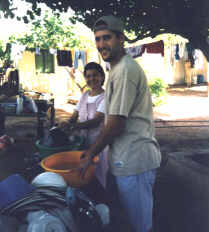
YES BC Volunteer assists in Youth Outreach in Mexico:YES BC photo. There are many in Canadian Mennonite churches who are not satisfied with being the"quiet in the land." They believe that the church should look beyond itself and try to affect those outside of it, and have called for a more concerted effort in actively inviting others to join the church. This perspective has been a major driving force behind the unprecedented mission work which has occurred during the 20th century.
This evangelism has concentrated on peoples' personal decision, followed by living up to this commitment in leading a moral life. In this view the church seeks to increase the number of people living under Jesus' direction, which will have an effect on the people and society around them. This emphasis has led to the creation of the Youth Evangelism Service (YES) program, and other projects. Social Justice 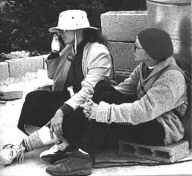
CPT Members in Sit-Down Protest against the Demolition of Homes in Hebron:CPT photo. 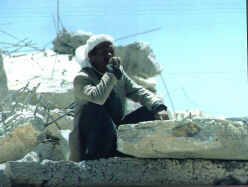
Palestinian Man Weeping on his Demolished Home:CPT photo. Since World War II there has also been an increased interest in social justice in many Mennonite churches in Canada. People who emphasize this aspect see justice and peace as interconnected, and often use the Hebrew idea of "Shalom" (peace, well-being) to support their views. Like the former perspective, advocates for social justice believe the role of the church pushes beyond its own boundaries. Rather than concentrating on the decisions of individuals, however, the church's role broadens to work for justice in the larger society.
Proponents of social justice often believe that the church's prior commitment not to "resist evil" (non-resistance) led Mennonites to be inactive. Instead, many propose "non-violent resistance," where the church challenges injustice, but refuses to use violence in doing so. This relatively new perspective has given rise to the practice of Restorative Justice, as well as Christian Peacemaker Teams (CPT) and other projects.
Today In Canada today there is no open persecution of Mennonites because of their religion. In fact, Mennonites can be found in most career paths: from childcare workers and teachers topolice officers, lawyers and judges, from farmers and craftspeople to successful business people and computer programmers.
Mennonites in Canada continue to hold a broad spectrum of views on peace issues, ranging from emphases on being the "Quiet in the land," to evangelism and social justice. The topic of "peace" continues to be addressed as different congregations, groups, and individuals attempt to live faithful Christian lives.
 |  |
 |  |  |
|
|
 |
|
|
 |
|
 |
|





